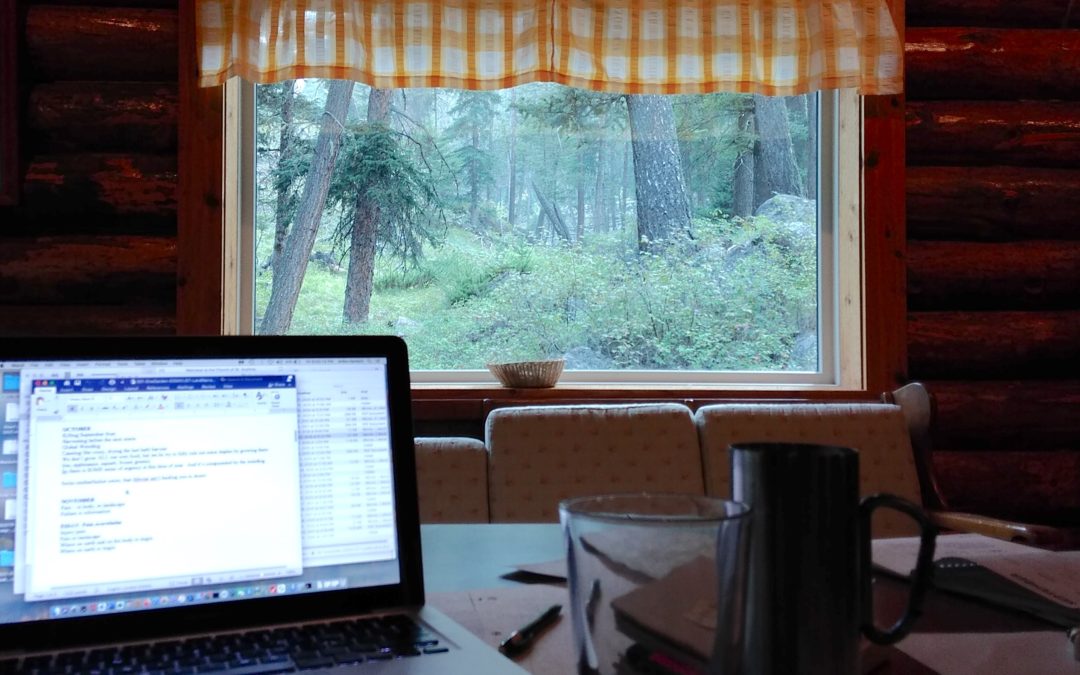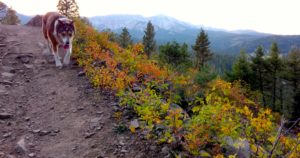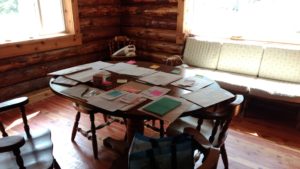It’s still early September, but we’ve started to see the first flushes of fall color. In Montana, our mid- and late-summers have become incredibly hot, dry, and smoky. So it’s hard to tell if the trees are changing because it’s true-autumn, or because they are drying out. Typically, a deciduous tree whose leaves turn brown or brown spotted is heat-stressed. Leaves that are turning vibrant yellow or orange or red are transitioning into true-autumn.
The reason behind that is fascinating. Deciduous leaves change color in the fall when the tree literally dismantles all the chlorophyll, pulling it out of the leaves and shuffling the chlorophyll components back into twigs and branches. Some nutrients are transferred down even further, for safe-keeping, in the root system during winter. Chlorophyll, responsible for the process of photosynthesis, is also the reason most tree leaves look green. Once removed, the leaf is left with whatever pigments it naturally contains, apart from chlorophyll green. Yellow and orange leaves tend to contain quite a few carotenoids. Red leaves contain anthocyanins. Once the chlorophyll decomposes, these other vibrant colors are revealed.
The tree is not comatose during dormant times, as I’ve written about in the past. Tree roots ponder and rearrange and concentrate materials during the winter months. It’s a kind of botanical house-keeping, not unlike the nesting we often do in our own homes during the coldest days.
The chlorophyll remains in storage until the spring thaw. Then all those component parts are rushed upward and outward within the spring sap run. This fuels the unfurling of new leaves and launches the first photosynthetic processes, which in turn fuel the tree’s growth and fruit or nut production that year.
What’s Chlorophyll Storage Got to Do with Writing?
I adore these dramatic transitions in temperate deciduous forests. It reminds me of the seasonal shifts in my own creative life. As someone who divides her life between writing and farming, I have learned to welcome the seasonality of my work life. In March (solar spring in the temperate north), as I begin starting plants indoors and finish up plotting out the microfarm’s growing season, I simultaneously send my latest creative project into a dormant state.
The farm’s growing season is not conducive to long stints indoors draft-writing or revising. Period. I’ve come to accept that. I don’t stop writing in the summer. But my practice looks more like the tree roots in winter: small scraps of text come to me throughout each day, I write them in a mini notebook while I’m out in the field, and at end of day I file them appropriately in a specific chapter or essay file. Not unlike the tree roots rearranging chlorophyll and glucose molecules, requesting its local microbiome for a few needed trace minerals and squirreling them away for use in spring.
Then the farm’s harvest season comes. It’s a rush of activity as days get shorter and many of my winter storage crops come in all at once. Days get shorter, so physical work ends earlier. I begin to pull out a notepad and jot draft notes after dinner. Writer’s Spring has just begun.
Just as solar spring comes in fits and starts—plenty of false starts and regressions back into dormancy around here—there’s a similar rhythm of activity-rest-activity with Writer’s Spring.
I’m on a scheduled writing retreat right now. it is the creative equivalent of an early spring thaw. I am in a literal cabin in the woods with a woodstove and a large table where I’ve spread out revision-plotting materials for my memoir.
The sap isn’t quite running yet (I’m not in full scale revision work yet), but I’m definitely playing with the building blocks and rearranging them, preparing for the surge of growth to come in October and November.
I’m basking in these warm creative thaw days. But I know—fits and starts—when I get back to the farm, I’ll head back into harvest mode. I won’t be surprised or saddened if the writing project heads back into dormancy for a week or two.
The Farm’s Winter is My Book Project’s Spring
This start-stop pattern will continue through October and November—a true transition time as farm and writing tasks duel with each other throughout. Sometime in November a true multi-day hard frost will occur that will end the growing season even in the lightly heated mini-hoop house. The farm’s winter arrives.
I sigh a contented and happy “yessss” and welcome the writing life to take front and center.
In December, draft-writing begins in earnest, though the writing always struggles some as we pass through the Land of Distraction that is the holiday period. Real growth in my writing project—on par with the kind that adds a growth ring to a tree—begins in January. The microfarm is completely and utterly still then. Apart from polishing a few end-of-season notes and seed ordering, my days will be dedicated to writing output, both for my ghostwriting or copywriting clients and for my own work in progress.
Those days will be defined by long hours indoors, at my computer or with a pen and notepad. My dog alone holds me accountable to getting outside at least once each day.
This is a highly sedentary creativity, and I’m grateful it’s not forever.
I’m similarly grateful that the physical exhaustion of the farm’s growing season is also not forever. This rhythm of inner and outer creativity, of cerebral and physical productivity, is a good fit for me.
The Best Writing Rhythm? It depends on the writer…
I know writers who write extensively every day, year-round. I know farmers in regions with year-round growing seasons, rotating between warm and cool-season crops. Somehow I don’t think that unchanging work life would work for me. I’m grateful for the contrast and seasonality of this lifestyle that I have settled into. And has settled into me.
Yes, I know many writers who commit to writing 1000 words per day at minimum, every day, year-round, even on holidays and weekends. They swear this is the only way to stay productive and truly finish their book drafts and draft revisions.
If you both farm and write, or guide and write, or host summer tourists and write, or have any other seasonal work that funds your writing life, you may find that your writing practice needs to adopt a seasonal flow as well.
What works for you? Drop me an email or post a comment sometime. I’d love to hear about other diverse writing practices and rhythms!
Anika Hanisch is a ghostwriter, line editor, and book coach who primarily serves natural health practitioners and people with unique survivor/thriver memoir manuscripts or book ideas. Take some time to learn more about her genre preferences, then contact her about involvement in your next book!





